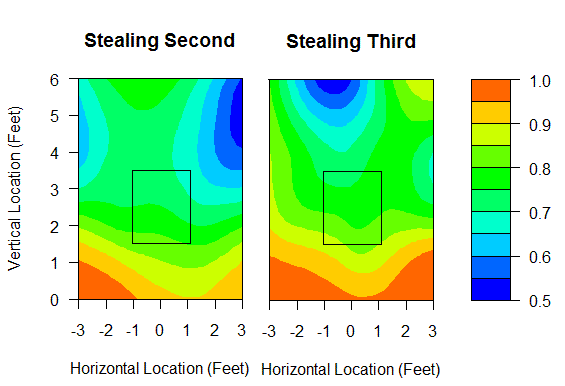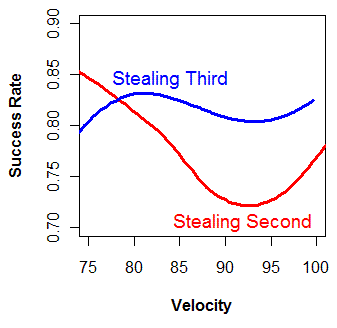
| Touching Bases | July 07, 2010 |
I tend to think that pitchers have more control over the running game than catchers. Catchers control their "POP" times, while the pitcher controls his time to the plate, pickoff move, pitch location, and pitch type. The last two factors are probably the least significant in determining the success of a stolen base attempt, but they're the most quantifiable thanks to PITCHf/x.
Below is the success rate of stolen base attempts from 2008-2009 based on the pitch location.

The trendline is clear. The catcher has no chance at throwing out a baserunner on anything that's less than a foot off the ground. Balls at the belt and up give the catcher a 70% chance at throwing out the runner, and pitches (pitch outs) in either batter's box really level the playing field.
Looking at these charts, I don't see why there aren't more lefty-throwing catchers. SB success rates are even at 76% regardless of the batter handedness, so throwing through the batter doesn't pose much of a problem. In fact, a pitch has to be located a foot off the plate for the batter's handedness to have a 10% difference on SB%. And, again, most of that is just due to pitch outs being thrown in the opposing batter's box.
Speaking of pitch outs, base runners were safe only 45% of the time on pitches classified as 'PO' by Gameday stringers. And considering the 70-75% success rate on regular fastballs, a couple tenths of a run are gained by pitching out when the runner is on the move. However, the data I'm using show that runners were in fact running during only 15-20% of all pitch outs. Furthermore, The difference between a pitch out and a regular fastball in terms of pitch type linear weights is at least a tenth of a run. Therefore, as currently employed, pitch outs would have to nab runners about 90% of the time to break even. I've always believed that the pitch out (and hit-and-run) have been over-utilized tactics, and I'm waiting to see some data refute that.
Jorge Posada and Mike Napoli, who both struggle throwing out runners anyway, call for a very high rate of pitch outs. Backups Jeff Mathis and Jose Molina, who are far from defensively challenged, also call for their share of pitch outs, so those calls are likely coming from the bench. Humberto Quintero and the lethally armed Lou Marson never call for pitch outs.
There are several reasons to throw more fastballs with a man on first than with the bases empty; there's a chance for the double play, incentive to avoid the passed ball, and, of course, to control the running game. John Baker and Joe Mauer both caught about 60% fastballs with nobody on, but 70% with a man on first. Along that same line, here's a snippet of the leader board for pitchers who throw more fastballs with a man on than with the bases empty.
| Rank: Pitcher | Bases Empty | Man On First | Team |
|---|---|---|---|
| 1: Anibal Sanchez | 53.20% | 71.30% | Marlins |
| 2: Sean West | 59.08% | 76.69% | Marlins |
| 3: Josh Johnson | 61.83% | 79.05% | Marlins |
| 4: Boof Bonser | 53.72% | 70.38% | Twins |
| 5: Matt Guerrier | 52.94% | 69.35% | Twins |
| 6: Chris Volstad | 62.31% | 78.64% | Marlins |
| 8: Leo Nunez | 53.67% | 66.89% | Marlins |
| 9: Burke Badenhop | 65.83% | 78.80% | Marlins |
| 11: Scott Baker | 59.56% | 71.87% | Twins |
| 12: Mark Buehrle | 69.74% | 81.39% | White Sox |
| 13: Andrew Miller | 66.02% | 77.34% | Marlins |
| 14: Nick Blackburn | 53.02% | 64.23% | Twins |
I don't know if it's Mauer and Baker, or if these organizations stress this strategy, or pure coincidence, but it's something. I included Mark Buehrle on the list because the man is, or he surely should be, legendary at fielding his position.
Of note, Gerald Laird, a terrific thrower, received fewer fastballs with a man on first than otherwise. Bartolo Colon and Trevor Hoffman shied away from their fastballs with a man on.
As for the other pitch types, base runners are successful 80-85% of the time running on off-speed pitches. Interestingly, on SB attempts of third, the lowest success rate has come on the knuckleball. Tim Wakefield must do a better job holding runners on second than he does on first. From the following, you can see that due to Wakefield, it appears that diminished velocity deters steals of third.

Combining velocity and location in a regression doesn't accomplish as much as I was hoping in terms of sorting out what catchers have had more or less difficult opportunities to gun down runners. Every catcher, save two, was expected to throw out 74-79% of base runners based on these factors alone. Only Wakefield's personal catchers Kevin Cash and George Kottaras have been forced to throw on especially difficult pitches. And they still have better numbers than Jason Varitek and Victor Martinez.
Comments
The reason there aren't more lefty-throwing catchers is the direction in which a throw tails depending on handedness: for a RH-throwing catcher, it tails into the runner, whereas for a LH-throwing catcher it would tail toward the 3B side of the bag. With controlled fastball-type throws, as from a pitcher, the man can exercise some control, but with the maximum-speed release a catcher has to make, the natural tail is hard to control.
Posted by: Eric Walker at July 7, 2010 12:05 PM
Interesting article. I'm surprised that stealing third has a much higher success rate overall. But I guess you don't see it that much since the runner is in scoring position already and it is considered a risky move to steal third because it is the old baseball adage not to make the out at third.
Posted by: RZ at July 7, 2010 1:32 PM
Eric, interesting theory. I would think that with the amount of repetition a catcher has in his delivery to second, he should have a pretty good idea of where the tail would take the ball. It must become muscle memory at some point, no?
RZ, yeah, the reward of stealing second is greater than stealing third so you can be thrown out more at second than at third.
Posted by: Jeremy Greenhouse at July 7, 2010 3:38 PM
I have long felt that the reason there are no LH throwing catchers is that it is HARDER to throw to 3rd as a LH-which would proably increase the steals of 3rd base.
Is it possible that a reason for more FB wi a Runner at 1st is that P/C is trying to reduce the chances of a BB thereby putting 2 men on? If Crawford/Reyes/Bourne is the Runner I can see it, Fielder, Molina,Dunn, not. Is the % adjusted for the runner as a Stealing threat?
Good stuff here- Thanks
Posted by: Luis Venitucci at July 8, 2010 4:48 AM
The best argument I have heard against the LH catcher is that you have to have a strong arm to be a catcher. Strong arm + throws left-handed = pitcher.
Intuitively I would think that it would be risky to throw that many fastballs with men. Sure you control the running game a bit more, but the batter has a much better idea of which pitch is coming. A home run scores a baserunner wether he is on 1st or 2nd. However, the Twins and Marlins seem to be the most with the least so they must be doing something right.
Posted by: Ryan at July 8, 2010 6:47 AM
Interesting, but I think you have to control for the pitch type at each location, correct? I'm guessing that one reason it's harder to throw out baserunners on low pitches is that those pitches tend to be breaking balls, reaching the plate later.
Posted by: nightfly at July 13, 2010 11:09 AM
I wonder if you have looked at the time it takes for the catcher to throw from home to second and vice versa. It seems to me there may be a good chance of scoring off stolen bases when there are runners on first and third. My scenario is as follows.
Runner on first base steals. Catcher throws to second. The runner on third leaves as soon as the ball is released by the catcher. The ball has to travel 127 feet to second base, the player has to catch the ball and then throw the ball back to home plate i.e. the ball has to travel a distance of 254 feet to get the runner at home versus 217 feet from pitcher to home to second. This doesn't of course take into account the fact that the player at second has to catch the ball and make a split second decision whether or not to tag the runner advancing from first.
Would be interested in your analysis of this scenario.
Posted by: Neil at July 18, 2010 8:56 AM